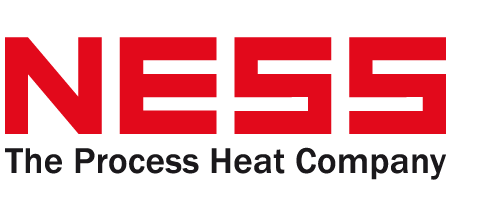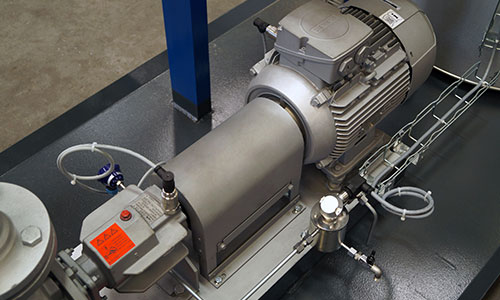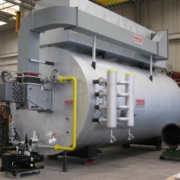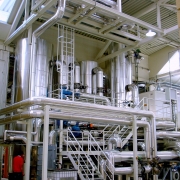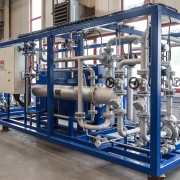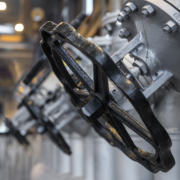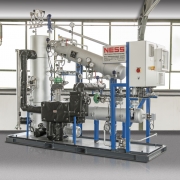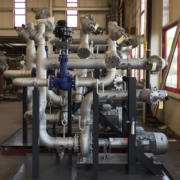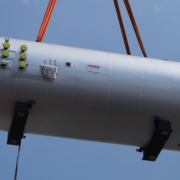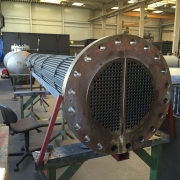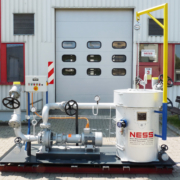Monitoring of pumps in systems with heat transfer medium –
monitoring of important pump parameters to avoid malfunctions and standstills
Pumps are the determining components in heat transfer systems with liquid heat transfer mediums.
As „heart“ of the system, they ensure that the heat transfer medium circulates in the system and the thermal energy provided by the heater is conveyed to the right position in the system. Therefore, an unforeseen damage on the pump represents a high economic risk. However, this can be avoided by suitable measures.
In principle, the pumps must be in proper condition and must regularly be serviced. To ensure this, it is required to plan regular inspections (e.g. for oil leaks) and regular maintenance. The regular inspections require trained personnel and discipline; furthermore, the pumps are often installed away from continuously checked parts of the system, so that they can easily fade from the spotlight. To avoid this, pumps can be equipped with relatively simple monitoring sensors providing many advantages while it is very cost-efficient compared with the purchasing costs of a new pump and the organisational effort of regular inspections on site. Even a damage on a component of a pump, e.g. a damaged bearing, can be repaired if detected early; otherwise at a later stage, most pumps must completely be replaced. The economic loss because of an unwanted standstill due to damage to the pump or even a fire caused by a leaking pump, more than ever exceeds the costs for a reliable pump monitoring.
„There are three indispensable factors in the concept of pump monitoring that should necessarily be monitored. These are monitoring of bearing temperature, pump vibrations and leakages. Already with relatively low costs it is possible to implement sound and reliable monitoring of these factors – completely independently from the make of the pump,” said Dominik Weidler, Technical Assistant to the Managing Director of NESS Wärmetechnik GmbH.
If implementing temperature, vibration, and leakage monitoring devices, two limits are specified. If the first value has been exceeded, a corresponding alarm is triggered in the control centre which shall then cause maintenance and inspection. If the second limit value has been exceeded, this causes the system to be switches off to prevent serious damages to the system.
Mainly for monitoring of vibrations and bearing temperatures, the sensors can detect deviations from the specified tolerance range early before an imminent damage is visible or audible. In the most cases, it will be possible to act preventively, so that maintenance measures can be planned and taken early enough.
„In addition to monitoring of vibrations and bearing temperatures, monitoring of leakages is really our „bestseller of monitoring units“, Mr. Weidler remarked. “Mainly wearing parts of pumps with slip ring seals get broken earlier or later and thermal oil leaks out. The nearer the lifetime of the seals comes to the end the more oil escapes. To avoid misinterpretation, in addition to the filling level we also measure the temperature of the leaking oil, to be able to safely recognise a suddenly occurring leakage. If the limit value of the filling level is exceeded and the temperature limit is exceeded too, that means that a large amount of hot oil escaped all at once. If this happens, it is very important to react fast and, if necessary, to initiate automatic switching off. For this purpose, leakage monitoring is a must-have.”
„To solve the problem of pump monitoring, NESS technically relies on proved and error-free sensor circuits and the integration in the already existing system control. It is particularly important to us to pick up the customer-specific control to be able to design everything as customer-friendly as possible and easy to implement.
Mainly in large-size companies, central processing has the advantage that monitoring takes place on the respective pump but can be managed centrally. With this, inconvenient routines on site are not required anymore.” Dominik Weidler says. „If implemented, furthermore the limit values make it possible to recognise imminent damages on bearings or other components early to prevent malfunctions. In this way, maintenance works can then be planned to be more targeted and reliable.”
No matter whether it has to do with monitoring of bearing temperature, vibrations, or leakages, pump monitoring generally is helping to recognise risks earlier and to be able to prevent something much worse. Therefore, pump monitoring can be counted to the most important factors in the field of system safety and it is very easy to implement, also as expansion kit for existing systems. Because it reduces the risk of failure or damage, this safety device pays off already from the first day of purchase.
